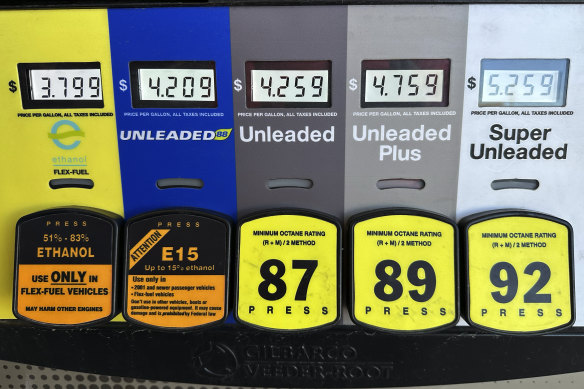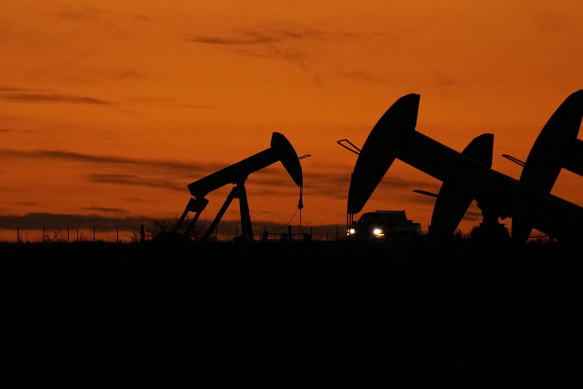
“Right now, the average driver in America is spending over $US100 less than if gas prices had stayed at their peak,” he boasted in January, echoing a multitude of similar claims made throughout 2023.
Unsurprisingly, he has been relatively silent on the issue as prices have surged.
‘Nothing terrifies a sitting American president more than a surge in pump prices during an election year.’
Bob McNally of Rapidan Energy, a former adviser to George W. Bush
When his administration has broached the subject, it hasn’t gone well. White House press secretary Karine Jean-Pierre’s claim on Monday that Biden had brought prices down prompted a public backlash.
“I would say that gas prices remain well below their peak back in 2022, I think that’s important,” she said.
“The average gas price right now is cheaper than this time last year, and that’s because of what this president has been doing over the last three years.”
Many didn’t see it that way. Road fuel inflation jumped by 3.8 per cent in February alone and then by 1.7 per cent again in March, according to US Bureau of Labor data.
The impact of those rises matters beyond just vehicle owners because the price of oil also has a powerful impact on overall inflation. Rising oil prices helped push the US inflation rate to 3.5 per cent for the 12 months to March.

Petrol prices were a big contributor to the March higher inflation data.Credit: AP
The latest data from the US Energy Information Administration (EIA), suggests more rises are in store. For example, US petrol demand rose from 8.61 million to 8.66 million barrels a day last week alone – but US gasoline stocks decreased by 1.1 million barrels to 227.4 million barrels.
Any further increases in demand, or a rise in global oil prices, will quickly push up pump prices.
The crucial period for petrol-based politics is yet to come. In the automotive industry, the Northern Hemisphere summer is known as “driving season” in the US because of the sheer number of people hitting the road to travel for holidays. It is then that the nation will feel the pressure of higher fuel prices most keenly.
For Biden, the prospects of prices stabilising seem slim.
“Gasoline prices of $US4 a gallon don’t seem far off, particularly since a geopolitical risk premium has returned to energy markets,” Dan Eberhart, chief of US oil field services company Canary, wrote in Forbes magazine this week.
“Rising tensions in the Middle East and Ukrainian drone attacks on Russia’s refining sector – the third-largest in the world and a critical exporter of refined product – are also driving prices higher.”
It poses a significant headache for Biden, with November’s elections coming just after driving season.
Loading
“Pump prices are very important to US elections and any incumbent president will do what he can to keep prices lower,” says Ashley Kelty, research analyst for oil and gas at investment bank Panmure Gordon.
“Look at the desperate and useless effort Biden made at the midterm elections by releasing reserves from the strategic reserve.”
Biden released 180 million barrels of oil from the national Strategic Petroleum Reserve in the months leading up to the 2022 midterm elections, with little discernible impact on price.
Kelty says: “That effort failed as the White House were too stupid to realise that prices are not impacted by local moves and that the Saudis openly laughed at them whilst choking back production to push prices higher.”
The key factors driving price rises are the fundamentals of supply and demand.

Oil prices do not look like falling anytime soon.Credit: AP
Global oil demand is predicted to rise by 1.4 million barrels a day to a new all-time high of 104 million barrels per day by the end of this year, according to the IEA. It predicts oil demand will not peak until at least 2030.
In theory oil producers could keep pace with that increase in demand. However, it offers them a golden opportunity to play the market.
Suppressing supply to drive up prices is the most obvious tactic. The 12 members of OPEC, the Organisation of Petroleum Exporting Countries, and the 10 associated members who make up OPEC+, including Russia, have made good use of it.
Last month, OPEC announced voluntary cuts of 2.2 million barrels a day for the second quarter of 2024. This was in addition to Russia’s decision to cut production by 471,000 barrels a day for the same period, which itself came on top of a 500,000 barrel cut in production announced in April 2023.
Some suspect OPEC and Russia of manipulating oil supplies and prices to undermine Biden’s hopes of re-election but McNally thinks that is unlikely.
“I don’t think OPEC+ leadership plays politics with its supply policies,” he says. “The cost of inducing ruinous oil price volatility would outweigh any political gain, and that assumes leading producers [its members] share the same political objectives.”
Still, oil prices do not look like falling anytime soon.
Jorge Leon, senior vice-president for oil and energy research at Rystad Energy, says: “Our forecast is that oil prices will remain elevated for the rest of the year, hovering around high $US80s.
“While it is impossible to envisage what will happen in the Middle East, our forecast assumes no significant escalation. But even without escalation, oil prices remain at this elevated level. This is because of the anticipated strong demand rebound during summer.”
Other analysts agree – but warn that escalating tensions between Israel and Iran are the great unknown in the equation.
For Biden, everything may depend on preventing escalating conflict in the Middle East – and escalating prices on US forecourts.









 Add Category
Add Category